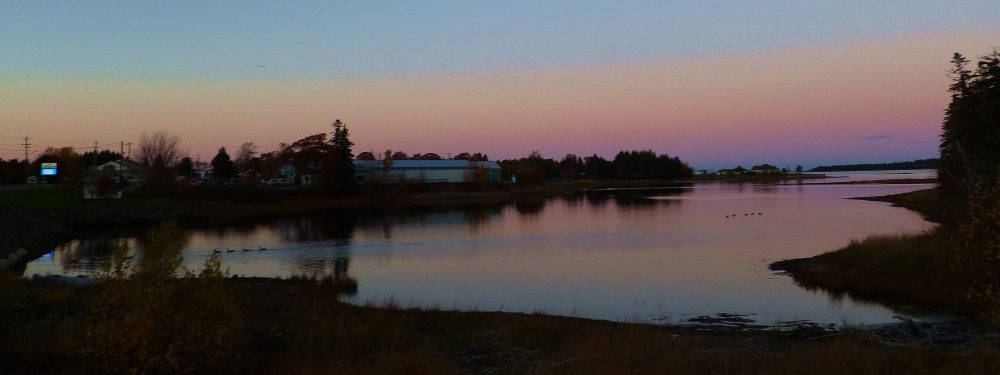Prepared for circulation to all Water Protectors:
Our Allies, in and around the Council of Canadians
Near Saglek Bay in Nunatsiavut, the homeland of the Labrador Inuit. ©Ossie Michelin
All waters—fresh and salt—are connected
For more than 30 years the Council of Canadians has been a leader on fresh water protection in Canada. In 1999, we published a comprehensive National Water Policy advocacy brief regarding how to protect watersheds and implementation of the human right to water.
Fresh water flows into the sea. Contaminants that flow into rivers and streams from industrial pollution, such as fracking and burst tailing pond dams, drain into estuaries, bays, seas, and oceans. These contaminants compound the abuse and neglect already poisoning the salt-watery majority of our planet. Survival of marine life, already stressed by acidification and warming waters, is further compromised.
The Council of Canadians is not loosening our efforts on freshwater issues. This is a “both/and,” because the planet’s waters are all connected. We are calling out across our organization, and to allies, to develop a coordinated, unified, strategic campaign on protecting coastal life and ocean waters. In a separate communication sent today, 24 chapters of the Council of Canadians ask the Prime Minister of Canada to meet with us to discuss the issues raised in this call to action.
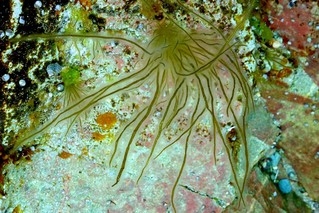
The magic of life in coastal waters, Gaburus, Cape Breton Island, NS. ©George Griffen
Our coasts are being neglected
Canada has a huge global stewardship responsibility. We have more oceanfront than any other nation. Gaining protective legislative and regulatory measures will not be easy. The plethora of issues is compounded by official lethargy and avoidance.
Every day, volunteers in the Council of Canadians‘ community chapters work with people from local networks and environmental NGO’s across Canada to advocate for marine life and salt water protection. We are united in alarm about the contamination that will certainly result from hundreds of oil and gas export tankers, each day, crossing the fragile and stressed waters of the Georgia Strait, Salish Sea, other western coastal waters, Bay of Fundy, Gulf of Maine, Beaufort Sea, and more of our shore waters. Much of the intended export material is bitumen, which truly cannot be cleaned from the water after a spill. Each of these areas provides habitats for designated species at risk and/or for marine life on which Indigenous Peoples and others depend for sustainable livelihoods.
In particular, Atlantic Canadians feel betrayed by government on marine protection: “Frankenfish” in PEI; aquaculture diseases spreading to wild populations (despite government assurances this would never happen); the evaporation of Newfoundland’s cod fishery; the loss of the salmon fishery in New Brunswick; the loss of some unique Striped Bass spawning habitat in Nova Scotia; off-shore drilling throughout the near Atlantic Ocean; etc.
Darren Porter’s Herring Weir, Minas Basin, NS. When other fish are caught,
such as this stupendous Striped Bass, they are released. ©Erica Danae Porter
Countless millions of dead herring: a case in point
Beginning mid-November 2016, dramatic mortalities of herring were evident in the Bay of Fundy—a powerful, unique ecosystem boasting the highest tides in the world, and is home to rare species such as the Right Whale, provides spawning grounds for the Striped Bass, and has a flourishing ecotourism industry.
Why the big fuss about the humble herring? The herring are a primary food source for larger marine life in the Fundy, as well as people food, bait for shellfish traps, and a significant resource export. Without herring, the Fundy fisheries collapse.
Contrary to frequent public messaging, energy generation by tidal turbines can seriously harm marine life. Depending on design, direct strikes can kill and injure animals caught in the mechanism. Arguably more insidious is the noise, vibration and pressure change disruption of the marine environment. Many at-risk sea mammals, and forage fish like herring, have very sensitive auditory biology. Despite the urgent need to generate energy from non-fossil fuel sources, this calls into question tidal power’s “green” status.
In April 2016, the Science Advisory Committee for the Maritimes of the Department of Fisheries and Oceans (DFO) reviewed a proposal to install an experimental tidal turbine in the upper Bay of Fundy. The DFO advisory committee clearly said the proponent’s baseline data was inadequate to establish an environmental monitoring plan. The province of Nova Scotia immediately approved the turbine’s deployment in the Minas Passage. Fishers’ associations are currently taking the province to court over this inconsistency.
Left: Busy Digby Harbour, NS. ©Pics by Mitch (FB)
Right: Sandy Beach, on the Northumberland Strait, NB. ©George Griffen
Turbine deployment happened in early November 2016. Within days of the onset of testing and commissioning, dead herring began beaching further down the Bay. DFO’s response was sluggish. While die-offs continued, the department spent weeks testing and retesting for “the usual suspects”: viruses, bacteria, algae bloom toxins, and predators. DFO acknowledged a unique “densification” or “aggregation” of herring in the die-off bays and coves (ie. overcrowding), but had no explanation for the phenomenon. (See this “A Sequel” link for more info on herringcide investigations and theories.)
Many residents, including fisherfolk, are certain the herring were affected by the turbine. People who know these waters believe the herring fled from the Minas area to similar marine environments further down the Bay. Injured or overcrowded, that is where the herring were seen swimming abnormally, losing strength, and ultimately dying. Repeated calls to government and industry – to please stop the turbine to determine if it was the cause of the herring die-off, or to send cameras and divers to the bottom of the Fundy in the Minas area – were ignored.
Throughout the entire “herringcide” event, DFO refused to acknowledge that the synchronous turbine disruption of the Bay’s marine environment demanded serious evaluation. Many observers feel this is due to politics: Nova Scotia wants tidal turbines to succeed. The province has invested a lot of cash and political capital in creating the Fundy Ocean Research Centre for Energy (FORCE) to start-up major tidal energy generation. Powerful corporations see a huge market for “green” Canadian electricity along the US eastern seaboard, involving undersea cable links from the controversial Muskrat Falls in Labrador, biomass generation at Point Tupper NS, and upcoming Fundy tidal generation.
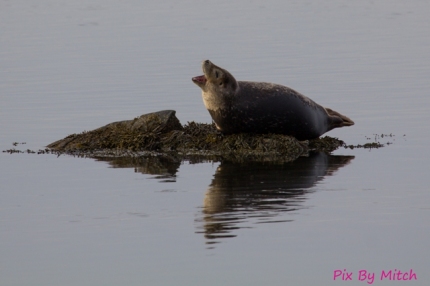
Seal near Annapolis Royal, off the Bay of Fundy, NS. ©Pix by Mitch (FB)
Deepening the public’s scorn for DFO’s controversial “look over here, not over there” herringcide investigation, a 2013 Memorandum of Understanding surfaced in early January 2017. This gives the National Energy Board responsibility to assess risk to fish and fish habitat near proposed pipelines and power lines. The possible existence of a similar understanding regarding FORCE initiatives in Nova Scotia could explain DFO evading questions about the new turbine’s possible effect on herring.
Like all such development proposals in Canada, Cape Sharp/Emera’s turbine in Minas Passage went through a provincial environmental impact assessment (EIA). This means that the proponent contracted a company that wrote an EIA report. The government then reviewed the paperwork, and approved the application. In some such instances, governments put conditions on approval, but the proponent is responsible for undertaking, monitoring, and reporting on their own compliance. This process is ridiculous. Asking the fox to install security for the henhouse is unacceptable and makes a mockery of the intent and meaning of environmental assessment.
In the past two months, more than 70,000 international and Canadian individuals have signed a petition calling on federal Fisheries Minister Dominic LeBlanc, Nova Scotia Premier Stephen McNeil and New Brunswick Premier Brian Gallant to address the issue of herring die-offs. On January 3, 2017, an open letter was sent to Prime Minister Justin Trudeau, and all these other political leaders, bringing their attention to the petition and asking for a response on key points. To date, none of the aforementioned have responded.
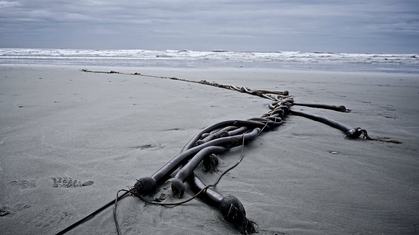
Bull Kelp on beach, Tofino, B.C. ©Alexandre Robichaud
The system is failing marine life, and us
This environmental crisis has brought to the forefront a host of broader concerns. DFO simply does not seem to be up to the job of protecting marine life. We understand that DFO’s scientific and species/habitat protection mandate is undermined by its multi-pronged mandate. Most significantly, DFO was hard hit by the extreme politicization of science, including restructuring and defunding, that happened during the Harper regime. At that time, scientists were muzzled, protection legislation was gutted, and key programs and personnel terminated.
As mentioned above, EIA processes across Canada do not protect the environment, and other protective legislation was stripped of its powers by the Harper regime. The Justin Trudeau government came into power promising to renew and revitalize Canada’s environmental regulatory system. Standing Committees and panels recently finished consultations on these ravaged laws. Each committee, dealing with each legislation, picked which major cities to visit (or not). All ignored frontline rural areas that are often most impacted by poor regulations. In the online consultation option, the questions funneled towards the interests of big government, not the affected communities. We will be watching to see what these consultations generate.
Left: Humpback whale & friends enjoy herring snack. Cape Bonavista, NL. ©George Griffen Right: Loon in winter coat, enjoying aneel, Bay of Fundy shore. ©Pix by Mitch
Environmentalist confidence in the Trudeau government further deteriorated with the November announcement of the Ocean Protection Program. Billed as being about proactive protection of the oceans, it prioritizes putting more resources towards clean up costs after anticipated shipping and pipeline accidents on our coasts. This is useful but not “protective,” which means “preventative” or “precautionary.” The Program also touts creation of more marine protected areas. Meanwhile, the very fragile and important Gulf of St. Lawrence is still open for oil and gas exploration where, intentionally or not, the planning processes are going slower than industry is moving.
“Consultation” seems to be the main public relations strategy of the current government. During the regulatory-related consultation processes in Fall 2016, many directly-affected stakeholders lacked resources and capacity to be at all tables and forums. In this vacuum, the Prime Minister recently held a few “pop-up” community town halls to demonstrate his sincere interest in hearing from ordinary Canadians. He was not seen in directly-affected or -threatened rural communities.
When marine life or habitat decimation occurs, other legal and ethical precepts come into play. In the instance of the herringcide, this happened on unceded Mi’kmaq territory. All of Canada is traditional Indigenous territory. The federal government has trustee responsibility for stewardship and protection of the resources, and is required to ensure that future generations of “Aboriginal” or Indigenous Peoples can enjoy their inherent rights to these resources. When profound environmental degradation occurs, the federal government is abrogating its fiduciary duty. Numerous related court cases are already in motion, eating up funds and personnel time that could go towards genuine protection. (See, for example, this link.)
More crises like the herringcide will be commonplace as our climate increasingly crisps and crumbles. Whenever this happens, those with the most direct knowledge of marine environments must be recognized as experts about what is happening in our own backyards: Indigenous traditional knowledge holders, fisherfolk, citizen scientists, naturalists, local environmental advocacy organizations, and ecotourism operators. These experts must be deliberately sought out, and not evaded or fought, by departments and agencies such as Environment and Climate Change Canada, DFO, and provincial departments. We should not have to go to court to keep corporate actions in line with the public good.
The Council of Canadians represents more than 100,000 people across this nation in a network of more than 60 grassroots volunteer-based chapters who work with a wide cross-section of allies. The Council’s volunteers are backed by a national staff of experts. We deserve an opportunity to have the Prime Minister meet with us about meaningful protection of our marine areas.
Published on February 16, 2017 by the Council of Canadians – Kent County NB Chapter.
Contact us at coc.kent.county.nb@gmail.com.
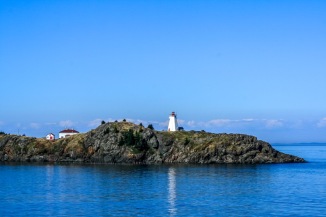
Swallowtail Lighthouse, Grand Manan, NB. ©Deborah Carr
Please Note: we will soon post our letter to the Prime Minister asking for a meeting.
It has already been co-signed by 25 Council of Canadians chapters across the country.
